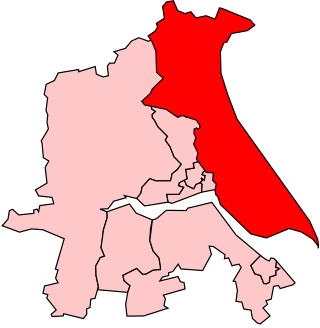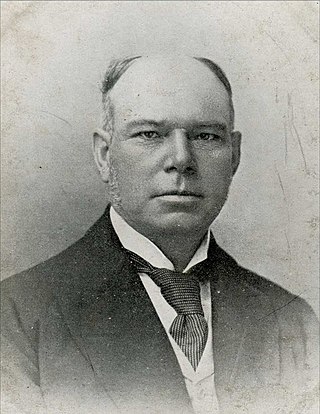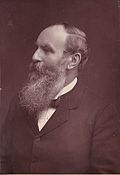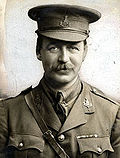
Thirsk and Malton is a constituency in North Yorkshire represented in the House of Commons of the UK Parliament since 2015 by Kevin Hollinrake, a Conservative.
Barkston Ash was a parliamentary constituency centred on the village of Barkston Ash in the West Riding of Yorkshire. It was represented in the House of Commons of the Parliament of the United Kingdom from 1885 until 1983. It elected one Member of Parliament (MP) by the first past the post system of election.

Bridlington was a constituency in East Yorkshire, represented in the House of Commons of the Parliament of the United Kingdom from 1950 until it was abolished for the 1997 general election. It was named after the town of Bridlington.

Beverley has been the name of a parliamentary constituency in the East Riding of Yorkshire for three periods. From medieval times until 1869 it was a parliamentary borough consisting of a limited electorate of property owners of its early designated borders within the market town of Beverley, which returned (elected) two Members of Parliament to the House of Commons of the English and Welsh-turned-UK Parliament during that period.

Petersfield was an English Parliamentary constituency centred on the town of Petersfield in Hampshire. It existed for several hundred years until its abolition for the 1983 general election.
Stepney was a parliamentary constituency centred on the Stepney district of the East End of London. It returned one Member of Parliament (MP) to the House of Commons of the Parliament of the United Kingdom, elected by the first past the post system.

Cleveland was a county constituency in the Langbaurgh Wapentake, North Riding of Yorkshire, England.

Sir Luke White was an English Liberal Party politician.

West Bromwich is a borough constituency represented in the House of Commons of the Parliament of the United Kingdom by Sarah Coombes of the Labour Party since 2024.

Croydon was a constituency in the House of Commons of the UK Parliament from 1885 to 1918. As with most in its lifetime following the Redistribution of Seats Act 1885, it was a seat, that elected one Member of Parliament (MP) by the first past the post system of election.
Osgoldcross was a parliamentary constituency in the Osgoldcross Rural District of West Yorkshire. It returned one Member of Parliament (MP) to the House of Commons of the Parliament of the United Kingdom, elected by the first past the post system.

Newington West was a parliamentary constituency in the Newington area of South London. It returned one Member of Parliament (MP) to the House of Commons of the Parliament of the United Kingdom, elected by the first past the post system.
Northern West Riding of Yorkshire was a parliamentary constituency covering part of the historic West Riding of Yorkshire. It returned two Members of Parliament (MPs) to the House of Commons of the Parliament of the United Kingdom, elected by the bloc vote system.
Eastern West Riding of Yorkshire was a parliamentary constituency covering part of the historic West Riding of Yorkshire. It returned two Members of Parliament (MPs) to the House of Commons of the Parliament of the United Kingdom, elected by the bloc vote system.
Southern West Riding of Yorkshire was a parliamentary constituency covering part of the historic West Riding of Yorkshire. It returned two Members of Parliament (MPs) to the House of Commons of the Parliament of the United Kingdom, elected by the bloc vote system.

East Somerset was the name of a parliamentary constituency in Somerset, represented in the House of Commons of the Parliament of the United Kingdom between 1832 and 1918.

Buckrose was a wapentake of the historic East Riding of Yorkshire, England consisting of the north-west part of the county; its territory is now partly in the modern East Riding and partly in North Yorkshire. Established in medieval times, it ceased to have much significance in the 19th century when the wapentakes were succeeded by other administrative divisions for most local government purposes. Buckrose was formed from parishes of earlier wapentakes, including some from the Domesday-era wapentake of Toreshou.
The East Riding of Yorkshire is a local government district with unitary authority status, and is a ceremonial county of England. It is named after the historic East Riding of Yorkshire which was one of three ridings alongside the North Riding and West Riding, which were constituent parts a Yorkshire ceremonial and administrative county until 1974. From 1974 to 1996 the area of the modern East Riding of Yorkshire constituted the northern part of Humberside.
The 1911 Kingston upon Hull Central by-election was a Parliamentary by-election held on 5 July 1911. It returned one Member of Parliament (MP) to the House of Commons of the Parliament of the United Kingdom, elected by the first past the post voting system.
The 1926 Buckrose by-election was a parliamentary by-election for the British House of Commons constituency of Buckrose, Yorkshire on 5 May 1926. This was the first by-election to take place during the General Strike.
















